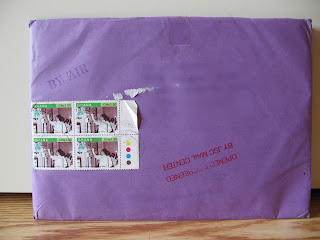The rescans from Aker Imaging were good, but there were still contrast problems in some of the images. Plus they were 60 cents a frame, which is more than it cost to develop each frame. I knew that Costco had film lab services, so I thought I'd bring in the same black and white film for them to scan. The Costco scans ended up being about 30 cents a frame, with is much cheaper, and even though I only asked them to do raw scans with no additional post processing, all the contrast issues were gone. Here's an example of a wild pony at Chincoteague:
 You can see that in the original scans, you can barely see the details of the horse and trees. You can also see that the left and right sides of the scan are darker than the center. The rescan pretty much solves the contrast issues, but there is still the brightness gradient towards the center. In the Costco scan, you can see all the details of the horse and trees (although the details in the sky are lost) and the brightness gradient is completely gone (all parts of the image are illuminated evenly). Here's another example of the Capitol Building:
You can see that in the original scans, you can barely see the details of the horse and trees. You can also see that the left and right sides of the scan are darker than the center. The rescan pretty much solves the contrast issues, but there is still the brightness gradient towards the center. In the Costco scan, you can see all the details of the horse and trees (although the details in the sky are lost) and the brightness gradient is completely gone (all parts of the image are illuminated evenly). Here's another example of the Capitol Building: The same problems exist in the original scan. Parts of the sky are saturated, the trees are black, and in the center of the image it is difficult to tell when the building ends and the sky begins. The rescan is a little better, but the Costco scan is clearly the best, showing all the relevant information in the photo.
The same problems exist in the original scan. Parts of the sky are saturated, the trees are black, and in the center of the image it is difficult to tell when the building ends and the sky begins. The rescan is a little better, but the Costco scan is clearly the best, showing all the relevant information in the photo.Bottom line, while the Costco scans may not always look the best, they show all the image details I need without any artifacts so that I can tell which photos are good and which are not.



